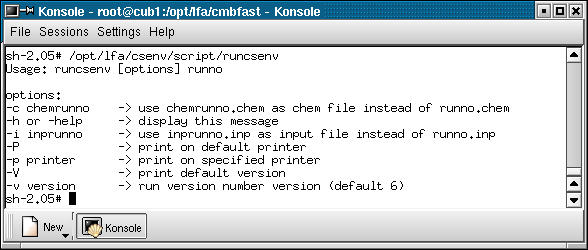Contents
Previous
Next
A code for the chemistry of CircumStellar ENVelopes
Version : 6.0
Author(s) : Gary Mamon and Al Glassgold (gam@iap.fr)
License : GPL
Website :
http://www.iap.fr/users/gam/SOFT/csenv.html
Disk space required for installation is 4.64 Mb
After the package is installed it can be accessed using the command
/opt/lfa/startcsenv
A shortcut will be installed in the KDE/GNOME desktop menu system,
as an entry in the Astronomy submenu
Summary
CSENV is a code that computes the chemical abundances for a desired set
of
species as a function of radius in a stationary, non-clumpy,
CircumStellar ENVelope.
The chemical species can be atoms, molecules, ions, radicals,
molecular ions,
and/or their specific quantum states.
Collisional ionization or excitation can be incorporated through
the proper
chemical channels.
The chemical species interact with one another and can are subject
to
photo-processes (dissociation of molecules, radicals, and molecular
ions as
well as ionization of all species). Cosmic ray ionization can be
included.
Chemical reaction rates are specified with possible activation
temperatures
and additional power-law dependences.
Photo-absorption cross-sections vs. wavelength, with appropriate
thresholds,
can be specified for each species, while for H2+ a photoabsorption
cross-section is provided as a function of wavelength and
temperature.
The photons originate from both the star and the external
interstellar
medium. The chemical species are shielded from the photons by
circumstellar
dust, by other species and by themselves (self-shielding).
Shielding of continuum-absorbing species by these species (self and
mutual
shielding), line-absorbing species, and dust varies with radial
optical depth:
* exponentially [exp(-tau)] for internal radiation
* with the Morris Jura (1983) approximation of a pure spherical
1/r^2 absorber (neglecting scattering) [exp(-1.644 tau^0.86] for
external radiation, but can alternatively be specified as
exponential
or taken from a file (see above)
Shielding of line-absorbing species (e.g. CO, H2) can be
incorporated:
* for external radiation, the code applies the escape probability
formalism times a continuum shielding factor (Morris Jura 1983),
the latter being made up of the contributions from dust, H2
blocking,
and continuum, blocking from other species. The dependence of the
shielding factor on optical depth is again taken from Morris Jura's
approximation of a pure spherical 1/r^2 absorber, but can
alternatively be specified as exponential.
* for internal radiation, the code assumes exponential shielding of
the continuum blockers (except from H2 lines)
The stellar and insterstellar radiation fields are respectively
black-body
and a good match to Draine's (1978) fit, by default, but can be
altered.
The envelope is spherical by default, but can be made bipolar with
an opening
solid-angle that varies with radius. In the non-spherical case, no
provision
is made for photons penetrating the envelope from the sides.
The envelope is subject to a radial outflow (or wind), constant
velocity by
default, but the wind velocity can be made to vary with radius.
The temperature of the envelope is specified (and thus not computed
self-consistently).
The data from all input files is fit to cubic splines (log X vs log
radius,
or log wavelength, except for species cross-sections which are fit
to linear
cubic splines and dust selective extinction). Internal wavelength
integrations for photo-rates and mean cross-sections are obtained
by cubic
spline fit to the linear relations.
The code starts out at the base of the wind, and integrates
outwards the
(photo-)chemical orindary differential equations, using Gear's
stiff method,
along steps of log (radial distance), with much smaller internal
steps of log
(radial distance).
The integration is repeated in the case of shielding of
interstellar
radiation, so as to use the ith order estimate of the column
density N(r) for
the (i+1)th order photo-chemical integration. Convergence is based
upon the
absolute variations from one iteration to the next of the column
densities of
all continuum photo-absorbing species as well as the total column
density.
Screenshots

Contents
Previous
Next

